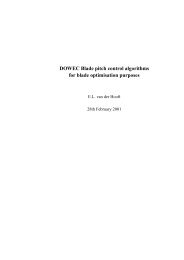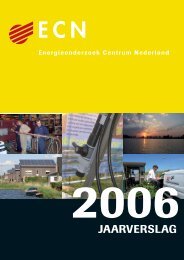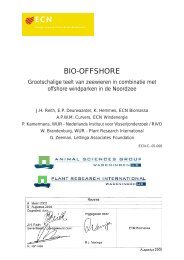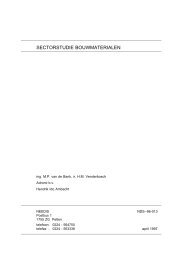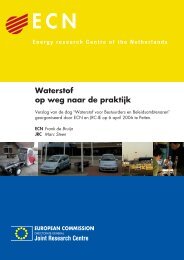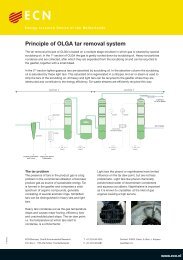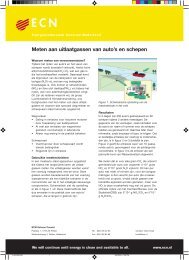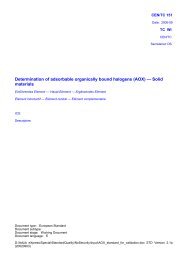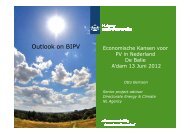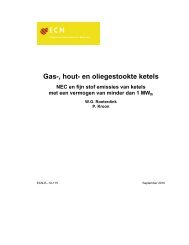PDF format (503 kB) - ECN
PDF format (503 kB) - ECN
PDF format (503 kB) - ECN
You also want an ePaper? Increase the reach of your titles
YUMPU automatically turns print PDFs into web optimized ePapers that Google loves.
duction system of fuels. For this reason, our analysis is performed for the energy use of transport. Calculation of<br />
the energy use reduction potential excludes the reduction potential of external factors and in this way, the contribution<br />
of the transportation sector is highlighted. At the end of this paper, some attention will be given to the<br />
interpretation of the energy use reduction potential to CO2 emission reduction potential.<br />
The energy use of 2.3 MJ per passenger kilometre is the value for the standard 1990 passenger car. Over time,<br />
passenger car characteristics also change. For this reason, the development in car characteristics are implied in<br />
the analysis. The development in vehicle weight is the most important characteristic for our analysis, as this<br />
relates directly to the fuel economy of a vehicle. A ten per cent weight increase generally results in a five per<br />
cent decrease of fuel economy (Hughes, 1993).<br />
Vehicle weight has increased steadily during the last decades. Two factors influence this weight increase: the<br />
demand for ever larger cars and the addition of more and more safety features and gadgets. Figure 2 displays<br />
the development in Dutch passenger car weight, a good representative of the developments of the average<br />
European car.<br />
Figure 2 shows a clear increase in vehicle weight for both the weight of newly sold cars and the average weight<br />
of the vehicle fleet. This trend is not likely to change in the coming years. Therefore, it is assumed that the average<br />
vehicle weight increases from 1000 kg in 1990 to 1220 kg in 2020 and 1270 kg in 2050. Figure 3 displays<br />
the expected trends in vehicle weight for Europe between 1990 and 2050. The weight increase causes a 17<br />
per cent higher fuel use by 2050 compared to 1990 at constant engine performance (Bouwman and Moll, 1997).<br />
Improvement options<br />
Reducing the energy use per passenger kilometre is possible by changing the magnitude of the direct energy<br />
use, the indirect energy use and the occupancy rate (see figure 1). Changing the ERE values is not fully included<br />
in the present analysis; since reduction in the ERE values requires changes in the energy producing<br />
sector.<br />
Not all possibilities to reduce the energy use per pkm are equally easily to be introduced. Therefore, we make a<br />
subdivision in four categories, each with increasing problems for implementation. The technological improvement<br />
options are derived from the database gathered by (Binsbergen et al., 1994). In (Ybema et al., 1995) a<br />
selection of these options is made, and efficiency improvement figures for 2000, 2015 and 2030 are calculated.<br />
We will use the figures of this database to calculate the reduction potential, supplemented with figures on the<br />
material substitution (Bouwman and Moll, 1997) and some non-technological options. The various categories<br />
of improvement options are described in more detail below. Table 1 lists a quantitative overview of the expected<br />
efficiency improvements.<br />
1. Options emphasising technological change<br />
Technological options generally have the lowest implementation problems. Options in this category will<br />
not influence the functionality of the vehicle. The options included in category 1 comprise the improved<br />
internal combustion engine (IIC), improved tyres and aerodynamics (ITA), continuous variable transmission<br />
(CVT) and modified frame (MF). The IIC includes many different options, like the lean-burn technol-



